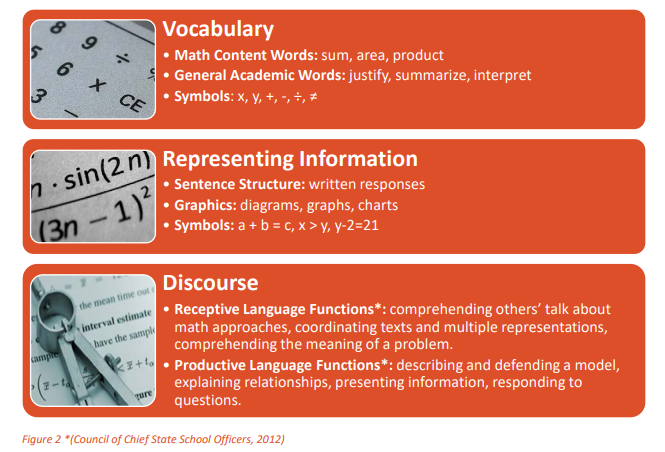Academic language (also referred to as academic English, disciplinary language, scientific language, critical language, and language of school) helps define school success for all students. It is the language of textbooks and homework, the language found in assessments, and the language students hear and see in all classrooms. This language is different in register (the words, phrases, and expressions used to talk about content-specific concepts), structure, and vocabulary from everyday language. Academic language is at the heart of grade-level curriculum across content areas (Gottlieb & Ernst-Slavit, 2014). Academic language includes: vocabulary, representing information, and student discourse.

It is important for educators to be aware of the challenges students face in mathematics with regard to academic language. Language development is not limited to vocabulary instruction, but also includes “instruction around the demands of argumentation, explanation, analyzing purpose and structure of text, and other disciplinary discourse” (Zwiers et. al., 2017). To support the development of academic language in mathematics, learning environments should include speaking, writing, diagramming, and gesturing. Access to learning, that promotes conceptual development, is necessary for all students (Walqui, 2009).
 Mathematical vocabulary is more likely than ever to have an impact on students’ math success because students need to understand math-specific words, words with multiple-meaning, and mathematical symbols to develop proficiency in math vocabulary (Pierce & Fontaine, 2009). Explicit teaching (direct instruction) should address words that have multiple meanings, concepts that can be represented with multiple terms, awareness of symbols and diagrams as they relate to mathematics, and the connection between mathematics vocabulary and everyday vocabulary (Roberts & Truxaw, 2013). To learn the math vocabulary needed for success, educators should engage students in rich and lively activities. These activities should encourage deep processing of word meanings and provide a range of opportunities to encounter math vocabulary (Pierce & Fontaine, 2009).
Mathematical vocabulary is more likely than ever to have an impact on students’ math success because students need to understand math-specific words, words with multiple-meaning, and mathematical symbols to develop proficiency in math vocabulary (Pierce & Fontaine, 2009). Explicit teaching (direct instruction) should address words that have multiple meanings, concepts that can be represented with multiple terms, awareness of symbols and diagrams as they relate to mathematics, and the connection between mathematics vocabulary and everyday vocabulary (Roberts & Truxaw, 2013). To learn the math vocabulary needed for success, educators should engage students in rich and lively activities. These activities should encourage deep processing of word meanings and provide a range of opportunities to encounter math vocabulary (Pierce & Fontaine, 2009).
Teaching students to interpret and represent information in mathematics is complicated, as it requires more than reading and writing text. Students must learn to interpret and demonstrate their mathematical thinking through written explanations, symbols, and graphic representations. Educators must teach students the skills needed for success. Teaching sentence structures in mathematics is important to comprehension since often every word within mathematical texts or word problems is essential (Adoniou, 2014). Students might know the meaning of certain academic math words. However, if they cannot put them in a comprehensible sentence, knowledge of academic words alone will not help them be successful
(OSPI academic language toolkit).
 When students engage in mathematics and are taught to provide meaningful explanations, higher level thinking and reasoning is promoted. Meaningful mathematical discussions help build knowledge and support the mathematical learning of all students in a math-talk community (Wagganer, 2015). The National Council of Teachers of Mathematics (NCTM, 2014) Principles to Actions includes communication as a process strand that highlights the importance of language skills in mathematics classrooms. Students need multiple opportunities to use academic language by engaging in meaningful discourse. The Common Core’s Standards for Mathematical Practice (SMP) state that students should engage in discussion that constructs viable arguments–SMP 3, critiques each other’s reasoning–SMP 3, and communicates with precision–SMP 6 (CCSSI 2010, p. 6-7). Academic discourse helps to develop conceptual understanding and improve language use (Hill & Miller, 2013). Conversations for students developing mathematical language may serve as scaffolding because opportunities to make and communicate meaning are provided (Zwiers et. al., 2017). Students benefit from collaborative discussions because mathematics conversation provides:
When students engage in mathematics and are taught to provide meaningful explanations, higher level thinking and reasoning is promoted. Meaningful mathematical discussions help build knowledge and support the mathematical learning of all students in a math-talk community (Wagganer, 2015). The National Council of Teachers of Mathematics (NCTM, 2014) Principles to Actions includes communication as a process strand that highlights the importance of language skills in mathematics classrooms. Students need multiple opportunities to use academic language by engaging in meaningful discourse. The Common Core’s Standards for Mathematical Practice (SMP) state that students should engage in discussion that constructs viable arguments–SMP 3, critiques each other’s reasoning–SMP 3, and communicates with precision–SMP 6 (CCSSI 2010, p. 6-7). Academic discourse helps to develop conceptual understanding and improve language use (Hill & Miller, 2013). Conversations for students developing mathematical language may serve as scaffolding because opportunities to make and communicate meaning are provided (Zwiers et. al., 2017). Students benefit from collaborative discussions because mathematics conversation provides:
• Meaningful discussion.
• Oral language practice.
• A way for students to clarify what is being asked and what is happening in a problem.
• Time to process information and hear the thinking of others.
• Opportunities for teachers to model academic language, appropriate vocabulary use, thinking processes.
• Build common understandings and shared experiences (Echevarria, Vogt, & Short, 2009; Zwiers et. al., 2017)


